The Best Color Palettes and HEX Codes for Canvas Dashboards

Key Takeaways
Cute color codes makes a gentle warm and fuzzy using hex, RGB or Pantone and are great for web design, branding, graphics and moodboards. Pick from pastels, whimsical brights, earthy hues, or celestial blues to complement your project's vibe.
💫 Build Your Perfect Color Palette
Ready to create a personalized color palette that works perfectly with your style? Our comprehensive guide will help you build a wardrobe palette that enhances your natural features and fits your lifestyle.
Build My Palette →Begin with pastel candies for subtle sophistication, sugar cookies for lively sprightliness, forest faeries for tranquility, and easter skies for ethereal designs. Blend with neutrals to maintain designs accessible and readable.
Leverage color psychology to guide decisions and experiment with palettes for the feelings you'd like to invoke — be it calm, joy, trust, etc. Study cultural significance to have your palette hit just right with world audiences.
Cute color code by function in canvas or dashboards with pastels for data visuals, vibrant pops for navigation, and soft backgrounds for readability. Verify contrast ratios and utilize accessibility tools to maintain clarity of content for everyone.
Balance cute and professional with the 60-30-10 rule using a dominant neutral or pastel, a secondary cute color and a focused accent. Restrict accent colors to highlight calls to action without overpowering the layout.
Don't be limited by flat colors—incorporate textures, gradients and good font pairings to add a little depth and personality. Maintain a handy guide of correct hex codes and test combos for readability both on device and in print.
Cute color codes: short hex or RGB values that map to soft, playful hues used in design, branding, and UI. Some favorites are pastel pink (#FFC0CB), mint (#98FF98), baby blue (#89CFF0), and lavender (#E6E6FA).
Designers employ these hues to represent warmth, peace, and enchantment, usually combined with bold type for reach. To schedule palettes properly, track shade, brightness and contrast ratios (WCAG).
Our guide underneath discusses curated sets and quick-use suggestions.
📚 Recent Articles
What are cute color codes?
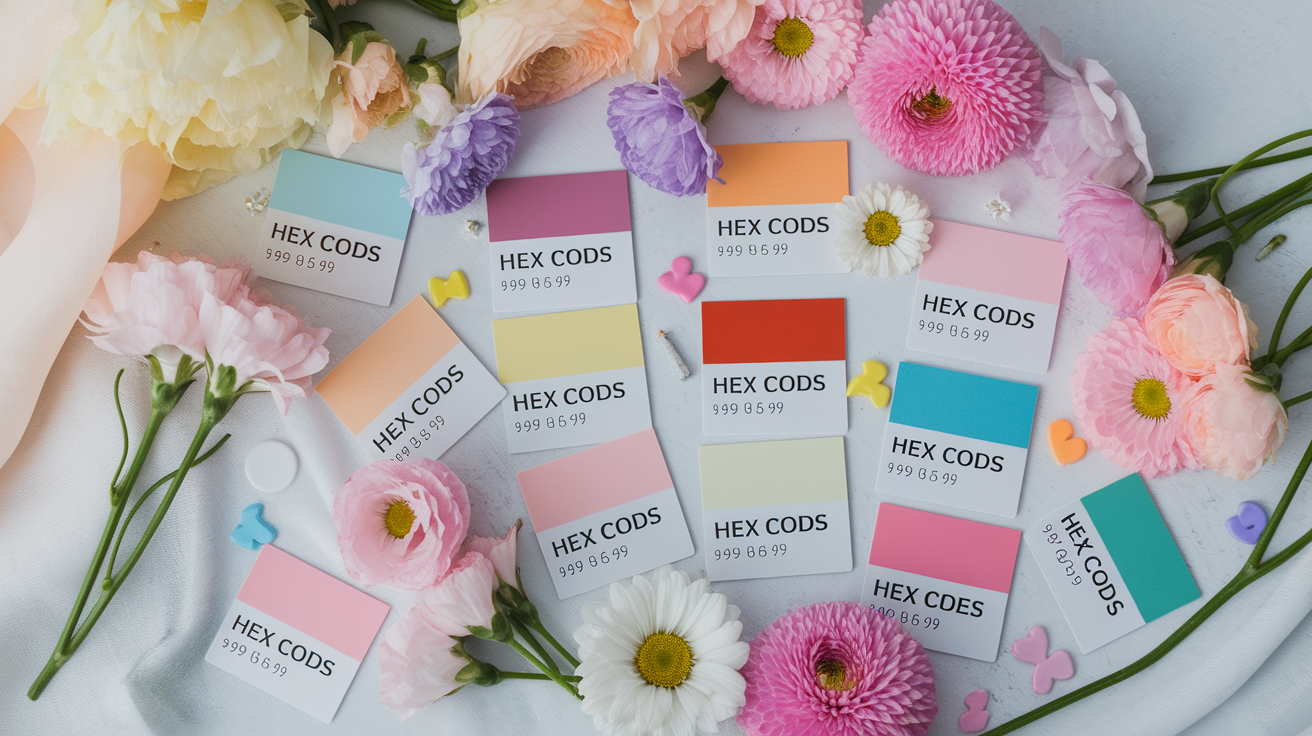
Cute color codes are flirty, darling blends of hex or RGB or Pantone values that skew girly, fanciful or gentle. Designers put 'em on websites and branding and graphics and moodboards to indicate warmth and comfort and happiness. They span from pastel sets to bright mixes, frequently combining pink, blue and gray hues for balance.
Examples many teams keep on hand: Pale Cerulean (#9BB8ED), Light Pastel Purple (#A39FE1), Classic Rose (#FEC6DF), and mix-ins like Thistle (#DEB3E0), Piggy Pink (#FFDDE4), and Papaya Whip (#FEECD6). Cute can mean muted boho or tropical brights, so long as the vibe remains soft and approachable with rounded shapes and less aggressive line work.
| Color palette | Hex codes | Recommended applications |
| Cotton Candy | #FEC6DF, #A39FE1, #9BB8ED | Hero banners, onboarding screens, gift cards |
| Meringue Pastel | #FFDDE4, #FEECD6, #E8F1FF | Backgrounds, cards, spa menus |
| Sunny Sherbet | #FB91C5, #FBDAFA, #FFF07A | Buttons, badges, social posts |
| Soft Meadow | #B49B9D, #E2CDCB, #D6E3D5 | Packaging, eco labels, moodboards |
| Sky Drift | #7AB1D9, #BBB4E3, #E3E6EE | Headers, gradients, dashboards |
1. Soft pastels
Pastel palettes evoke soft pinks, powder blues, mint greens and lavender purple for a gentle, dreamy feel. Try cute hex codes like #F3BCBC, #E8B9DD, and Pale Cerulean (#9BB8ED) as base layers, then throw a little white space in there to help them breathe.
Cute color codes – use these for canvas dashboards, cards and headers on content sites. Whether for weddings, spa branding or baby products, the look remains soothing and sophisticated without being boring.
Mix pastels with neutrals—warm gray, oatmeal beige, or a light taupe—to maintain equilibrium. Throw in one deeper accent for contrast, not noise.
2. Sweet treats
Candy-inspired sets favor bright pinks, lavender pastels and whimsical blues to ignite happiness. Cute color codes like #FBDAFA and #FB91C5 pop on buttons, icons and course cards.
Match bright pastels with soft neutrals so layouts remain both readable and friendly. Keep a small list of go-to combos for fast use: #FB91C5 + #9BB8ED + #FFF0F5, or Classic Rose (#FEC6DF) + Light Pastel Purple (#A39FE1).
3. Nature's charm
Earthy palettes utilize muted greens, sandy beiges, and soft browns for calm. Things like #E2CDCB and #B49B9D are wonderful for eco brands, organic packaging or interiors.
Throw in subtle metallics, like soft gold or champagne, to elevate green palettes without stripping them of their grounded-ness. Use them in moodboards, background blocks or logo marks to set a subtle mood.
Boho-inspired muted colors FEEL cute, not rustic.
4. Dreamy skies
Sky palettes introduce soft blues, lavender fields and gentle grays. Have you tried using #7AB1D9 and #BBB4E3 for backgrounds, headers and sleek gradients in web designs?
Combine blues with pastel purples and light grays for unity. A handy table in your style guide with every code and ideal application accelerates decisions as well.
5. Playful brights
Cute color codes? Try #F92D47 and #FC4C64 for banners and social posts. Combine brights with pastels to temper the energy and maintain a cute vibe.
Tropical touches can move the feel from cute to playful quick, ideal for youth-targeted brands.
The psychology of cute
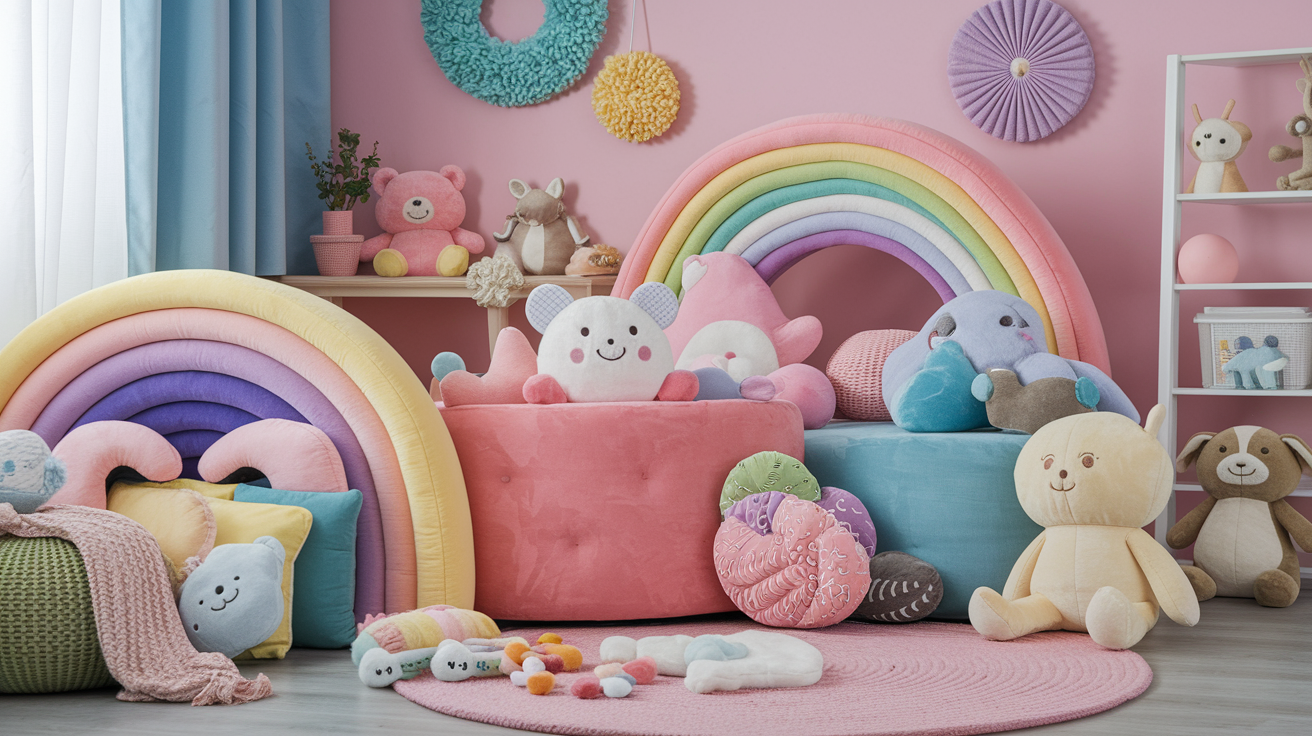
Cute color codes trigger a deep human instinct. Soft palettes recall all those baby signals—oversized eyes, circles, soothing contrasts—that trigger nurture and reduce danger. This "kindchenschema," so named by Konrad Lorenz, helps explain why pastel sets seem safe and sweet, and why users find cute stimuli more appealing, reliable and innocuous.
In design, that means longer dwell time, easier onboarding, and higher opt-in. Pastels and playful tones enhance mood, alleviate stress, and encourage tranquil concentration — handy in interfaces, packaging, and campaigns seeking warmth without raucousness. Match the message: quiet care with powder tones, joy with candy brights, sincerity with soft neutrals.
Cute can even go too far; some experience "cute aggression," a weird desire to squeeze, so maintain equilibrium with crisp contrast, white space and legible type.
Evoking emotion
Pastel pinks hint at warmth and love. Soft blues announce tranquility and calm seas and open sky. Subtle purples wink at nostalgia and daydreams. Both of them soften edges in the mind and slow the tempo, which is why a landing page with blush headers and pale sky accents seems less fraught.
Use cute color codes as uplift: an app badge in baby blue (HEX #A9D6E5) and blush pink (#F4C2C2) can make daily check-ins feel gentler, while packaging with lilac (#C8A2C8) cues gift-like delight.
Identify the desired mood first–warmth, excitement, tranquility–then select a base. Warmth: peach (#FFCBA4) with coral accents. Excitement: mint (#AEEBD5) plus sunshine yellow (#FFE066). Tranquility: powder blue (#BFD7EA) and dove gray (#E5E5E5).
Little test. A/B two palettes on key screens, log bounce and time-on-task, and run a quick survey: "calm," "playful," or "cluttered." Take the one users identify with the feeling you targeted.
Building trust
Calming blues, subtle greens and quiet neutrals make users feel secure. Imagine seafoam (#CDECE1), with slate text, or mist blue (#D7E6F5) and warm gray. These colors reduce perceived risk in signups and checkouts.
Carry through on site, emails, product shots. Repetition creates familiarity, and familiarity begets trust. A consistent palette appears more professional, which boosts credibility online.
Use contrast checkers for accessibility. Shoot for WCAG-ratios, so pastel-ui still reads. Plain text on gentle backgrounds says you respect every reader.
Cultural perception
Cute ain't one note all around the world. Pastel pinks can come off as youthful or romantic in certain regions, while lavender might indicate spirituality, modesty or mourning in others. Meanings change, and your palette selections should as well.
Study your target markets before you fix a scheme. Local focus groups and light surveys trump guesswork, particularly for global brands with diverse audience.
Kawaii palettes—sakura pinks, mint greens, butter yellows—blossomed in Japan and now color worldwide trends. They mix neoteny signals with play, which cultures interpret as novel and welcoming.
Evolve without selling out. Retain the fuzzed edges and approachable contrasts, but exchange tints to fit standards—peach for pink, sage for mint—so the overall layout remains cuddly and contextually appropriate.
Using colors in canvas
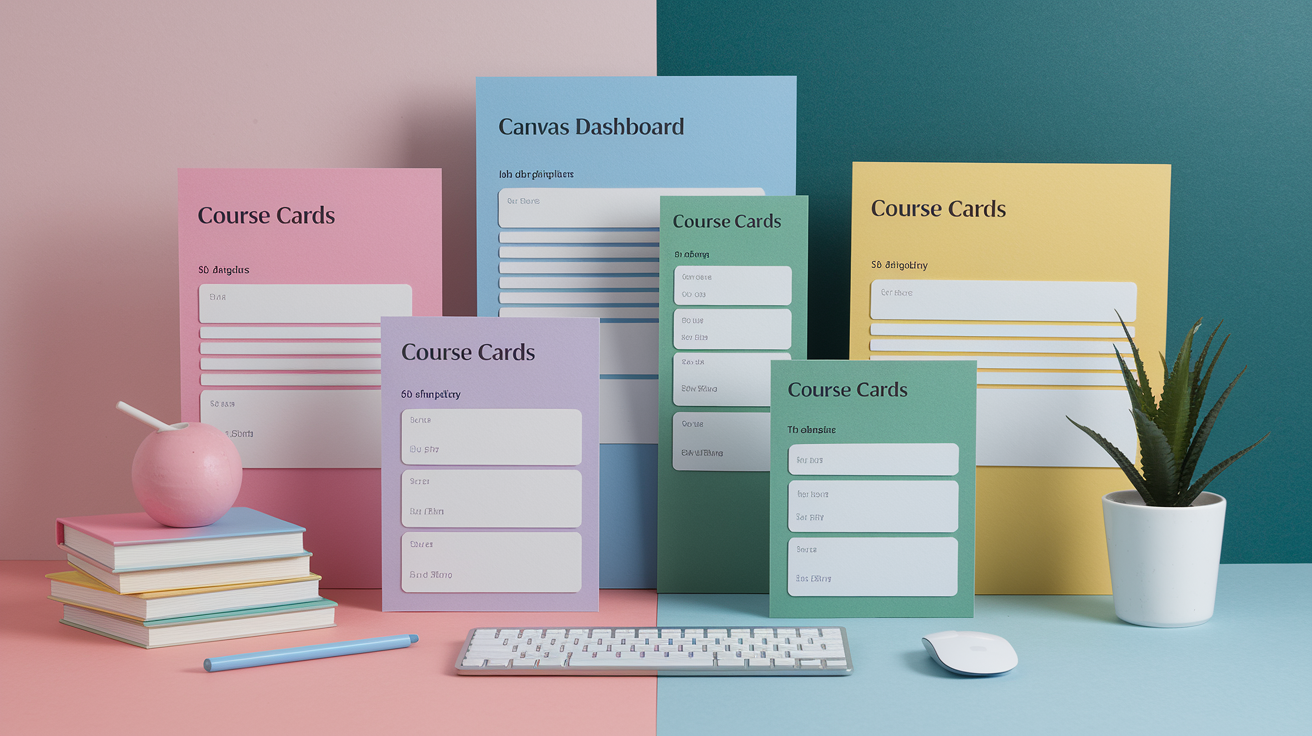
Pretty color codes influence how learners experience and navigate a canvas—on dashboards, course cards, and content pages. The right palette gets people to what matters, quickly, reduces visual noise, and establishes a tranquil tone.
Pastel palettes and soft tones work well because they keep attention on the content while adding appeal. Structure color by role—data, navigation, and backgrounds—to create a consistent, usable system that scales across components and platforms.
- Pastel codes for modules and elements:
- Announcements: #A7D8FF (pastel blue), #FFF1A8 (soft yellow).
- Assignments: #FFD6E7 (bubblegum pink), #C8F1E7 (mint).
- Quizzes: #C7D9FF (periwinkle), #FBE4C8 (peach).
- Discussion tags: #D9F4D4 (sage), #E9E6FF (lavender).
- Alerts: #FF9AA2 (rose), #FFD07F (apricot).
- Background base: #FBF4F2, #F0F0F7.
- Accent set (Easter-candy vibe): crisp turquoise #34D1CC, bright yellow #FFEB66, bubblegum pink #FFB3CE.
For data
Select complementary but different colored hues so charts remain crisp but still adorable. Blues and greens signal peace and confidence, which aids understanding during extended study stints.
Pastel blues, mint greens, and soft pinks hold your friendly visuals without screaming. Intensity, keep in check. Use one saturated accent—like neon red #FF1744—for a single callout line, then juxtapose it with muted tones so it pops without glare.
Triadic sets work well for dashboards: mint #9FE7C7, periwinkle #92A8FF, and peach #FFCBA4 balance each other. Cluster similar data with similar colors. For example, attendance bars in blue-tinged greens (#9FD9C8, #7CCBB5, #5BBFA6) all read as one family.
Monochrome runs (mint tints) assist to display progression without black or white.
For navigation
Use a vibrant accent from your cute set for the primary action: crisp turquoise #34D1CC or bubblegum pink #FFB3CE for the main button. Active states can sit in pastel blue (#A7D8FF), green (#BFEAD0), or lavender (#E6E4FF).
Keep dormant stuff in soft neutrals (#DADADA, #EDE7E3) to cut down on noise. Be consistent. One accent for primary, one for secondary, and a standby alert tone (brick red #B24A3A) when something needs eyeballs on it.
Brick red complements glossy black icons and white text for strong legibility. Try color on different devices and light modes. Test contrast ratios, hover and focus states, and color-only cues. Label and pattern for color-blind safety.
For backgrounds
Soft pastel bases cut down on glare and help you focus. Begin with #FBF4F2 for warm pages or #F0F0F7 for cool. Neutral grays and tans layer well and pair with just about any accent.
Add depth with subtle gradients: mint (#EAF9F3) to pale teal (#DDF2EE), or lavender (#F1EEFF) to periwinkle (#E3E9FF). Light texture at 5–8% opacity prevents pages from feeling flat.
Mind contrast: text at least 4.5:1. Dark slate (#2F3742) or rich charcoal works better than pure black on pastels. For highlights, a triadic micro-badge set—yellow #FFEB66, turquoise #34D1CC, pink #FFB3CE—pulls the eye without strain.
Balancing cute and professional
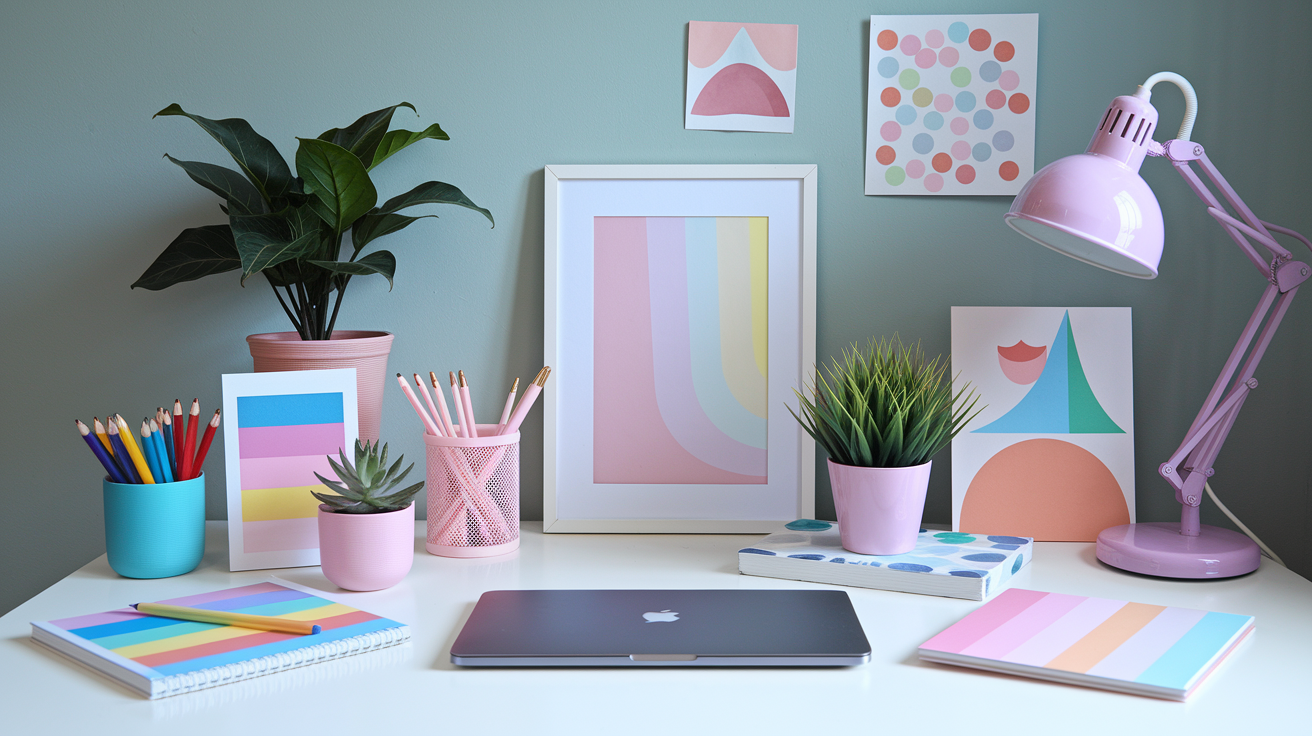
Cute color codes are fine in business when they fulfill clear objectives. The goal is cozy with classy. That means judicious use of color, minimal font selections, and photos that fit the narrative.
Study indicates soft pastels with neutral as a dependable foundation. Minimalism lets the frame stay clean and small notes of whimsy —icons, a micro-illustration— add charm without clutter. Others deploy whimsical accents to put teams, clients, or users at ease.
It can, but context and audience dictate where the line lies.
The 60-30-10 rule
Use 60% for the dominant neutral or pastel, 30% for a secondary cute color and 10% for bold accent. This cute/pro split informs web pages, decks, and brand kits, so the layout remains clean and the message reads first.
Apply it across surfaces: interface chrome (60) in warm gray or mist blue; content or cards (30) in lilac or peach; calls to action (10) in vivid coral or gold. It pairs well with typography—set headers in a clean sans-serif or serif for authority, and reserve a light script for tiny flourishes only.
| Dominant 60% | Secondary 30% | Accent 10% | Example HEX |
| Warm Gray | Blush Pink | Coral Red | #F5F5F5 / #F7C9D4 / #FF6B6B |
| Mist Blue | Lavender | Gold | #E6F0FA / #C7B8EA / #FFC94D |
| Soft Beige | Mint | Teal | #F2E9E4 / #BFEAD9 / #1CA3A3 |
| Pale Peach | Powder Blue | Raspberry | #FFE5D6 / #CFE6FF / #E6396E |
Tweak ratios as necessary–long data tables might push the neutral to 70% for readability. Maintain cohesion by keeping hue families constant and adjusting only saturation or value.
Context is key
Specify the objective, the target, and the niche. A fintech report demands quiet blues and cool grays, while a childcare site can play with brighter mints and sunny yellows.
My experience: education, wellness, and lifestyle accept more play. Legal, medical, and B2B services require more restraint. Softer colors work in formal rooms, atom is best for kids or playrooms.
Your selection changes brand perception, influences trust, directs clicks and reading time. Test on actual screens and actual prints. Check contrast, hover states and dark mode. Run rapid user tests to verify that the tone fits the objective.
Accent colors
Mix in bold pops from cute sets—vibrant pinks, teal or gold—to attract eyes to buttons, key links, tags, or data peaks. Keep accents tight, usually one color, so the UI isn't too noisy.
Put accents on call action spaces, alerts, or highlight strokes over a pastel or neutral background. Just be sure the accent bolsters the brand story and satisfies contrast guidelines.
Cute graphics like emojis or cartoons can warm the tone, but not all environments are appropriate for them. Couple accents with clean type hierarchy—sans / serif for body and headings, script just for small, non-essential tags.
Beyond the palette
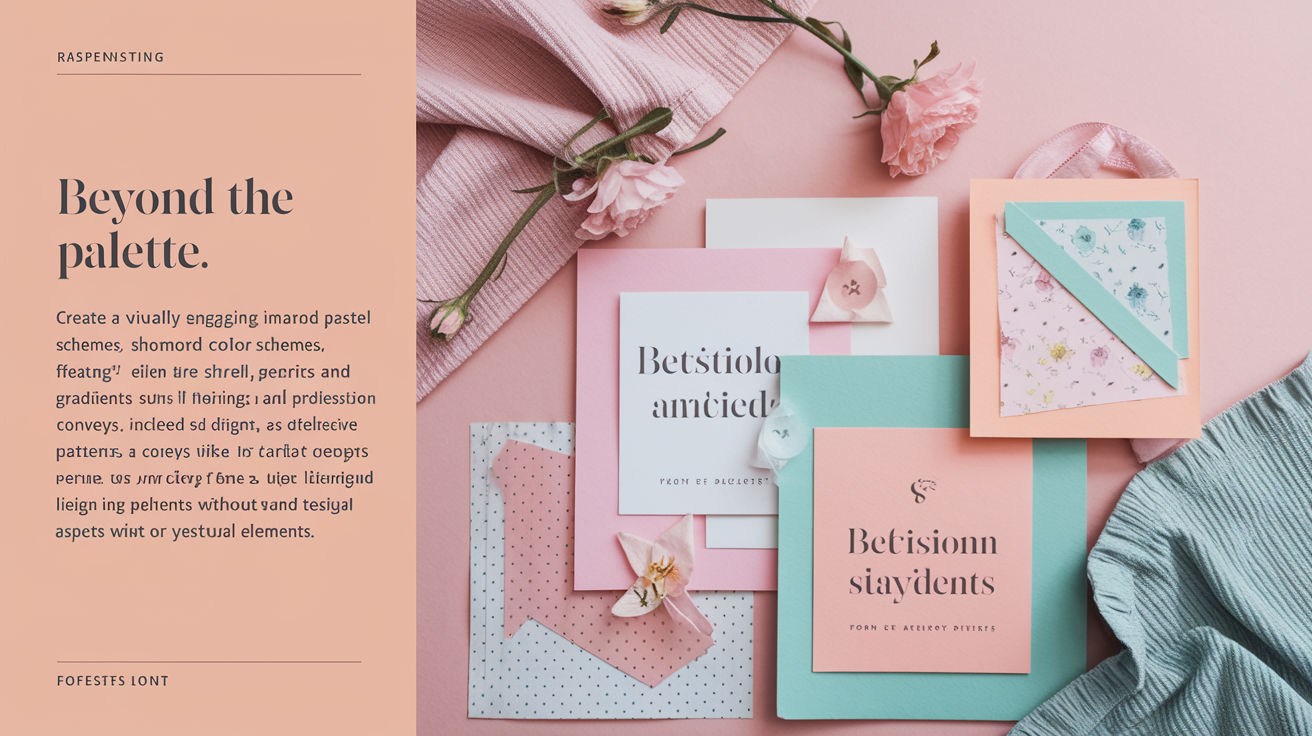
Cute color codes rock when color is just the beginning. A perfect cute color scheme, along with texture, gradients, and font decisions, creates mood, directs the eye, and keeps gentle hues from falling flat, igniting emotion and sculpting voice–playful to elegant.
Adding texture
Watercolor washes, paper grain, linen, terrazzo flecks or soft chalk dust inject soul into pastels without hijacking the spotlight. Light noise over a blush #F8C8DC base or a faint cotton paper grain on mint #CFF5E7 adds a dimensionality that hex values alone cannot.
As designers tell us, these decisions — particularly when they deviate from default flat fills — are part of creating a unique visual identity. Avoid being overly textural. Reduce opacity to less than 20%, blur edges, keep scale same so soft palette remains serene.
A creamy wash behind lilac #D9C2FF can imply warmth, while a crisp fiber paper on sky #CBEAFF keeps it clean. Apply textured backgrounds on moodboards to establish mood quickly, on brand kits to connect assets, and on web hero sections for a tangible, welcoming ambiance.
The trick is a slick touch that comes across human. Match texture to mood: whimsical likes watercolor bleeds and doodle strokes; vintage leans on faded paper, half tone dots or fabric weave; modern likes micro-noise, soft gradients and grain or crisp emboss.
Unexpected combos — like denim grain with pastel coral — can come across almost youthful and vibrant in just the right equilibrium.
Using gradients
Gradients melt sweet tones into a whimsical, contemporary landscape that brings texture without noise. Pastel ramps between pinks, purples, blues and greens look silky on screens and scale well for large backgrounds or tiny badges.
Use gradients on headers, buttons, cards or image overlays to direct attention. A diagonal blush-to-lilac button can be more memorable than a flat tint, and still read well with clear type.
- Peach #FFD1B3 → Bubblegum #FF8BC8
- Lavender #CDB7FF → Sky #BDE0FE
- Mint #CFF5E7 → Lemon #FFF6A5
- Periwinkle #AEB8FE → Soft Rose #F7A1B5
- Pistachio #B8E5C0 → Cotton Candy #F6B7F1
Unexpected combinations beyond the standard palette—such as sage paired with dusty peach—introduce an element of surprise, denote creativity, and set a playful or adventurous tone.
Font pairings
Choose fonts that fit the softness: rounded sans-serifs, humanist sans, and light scripts. A cheery rounded face on pale blue reads cozy without reading juvenile.
Pair strong, straightforward typefaces over light backgrounds for crisp contrast. A heavy grotesk on #FFF0F6 reads crisp — but keep your text colors dark enough to be comfortable.
Create hierarchy with scale, weight, and spacing. Bigger headings, ample line height and distinct margins leave layouts light and inviting. Try fonts and colors in combination on actual screens.
Test contrast ratios, hover states, small-size legibility. Striking, and still cohesive, bold schemes that extend beyond typical combos when type is controlled. It's where a lot of designers show style, and where work seizes memory.
Technical color guidelines
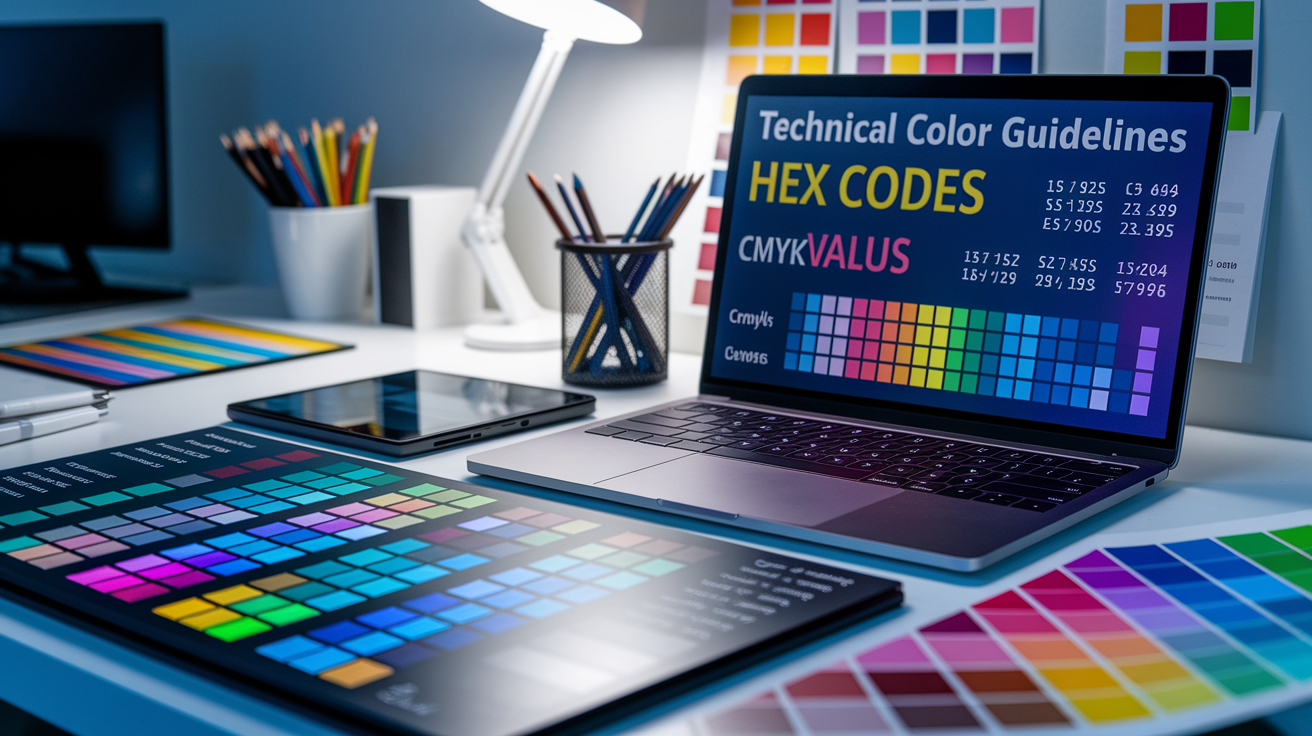
Precise codes maintain adorable palettes uniform across screens and print. Use hex for web, RGB for screens and CMYK for print to prevent shifts. Verify contrast to comply with accessibility standards and facilitate legible reading.
It's you and your prototyping tools against the evil adversary of late design changes and user dislike. Reference table below provides starter values.
Hex codes
Exact hex codes keep color consistent between CSS, HTML editors, and design software. One digit off can shove a pastel color into gray or neon, so copy-paste from a master file and lock it. Store them in a common style guide with names that correspond to their tone and purpose, ensuring the perfect cute color scheme is easily accessible.
Build a small chart for go-to hues: pastel pink #F8BBD0, baby blue #B3E5FC, mint green #B9F6CA, lilac #E1BEE7, and butter cream #FFF3C4. Additionally, keep a dark accent set for text and borders: charcoal #333333 and deep plum #4A2C5B, which can create beautiful color schemes.
Hex plays best with a small palette—one to three colors will often outperform a busy arrangement. A cute color palette keeps UI clean and brand recall strong. When you print, convert hex to CMYK and proof on paper, as soft colors can muffle the overall impact.
Verify codes prior to handoff. I maintain a "swatches" sandbox, and export test assets to catch drift between apps, ensuring the right color palette is used throughout.
Reference table (hex/RGB/CMYK):
- Pink Blush: #F8BBD0 / 248,187,208 / 1,25,4,0
- Baby Blue: #B3E5FC / 179,229,252 / 29,9,0,1
- Mint: #B9F6CA / 185,246,202 / 25,0,18,0
- Lilac: #E1BEE7 / 225,190,231 / 2,18,0,0
- Butter: #FFF3C4 / 255,243,196 / 0,5,31,0
- Charcoal: #333333 / 51,51,51 / 0,0,0,80
Contrast ratios
Good readability depends on contrast, not taste. Aim for WCAG AA at minimum: 4.5:1 for body text, 3:1 for large text or icons. Cute palettes skew light, so test every pair, particularly buttons, badges, and header bars where action lurks.
Validate combos with contrast checkers. If pastel on pastel doesn't work, darken text, outline, drop a subtle shadow. How about mint (#B9F6CA) with deep plum (#4A2C5B), for strong contrast and warmth?
Document acceptable pairs in a quick sheet: background, text hex, ratio, use case. It makes your reviews faster and guesswork-free on busy days.
Color theory to the rescue. Triadic sets can feel vibrant and youthful, while monochrome soothes. Light aqua and gold can signal vintage and timeless elegance.
Accessibility tools
Try out palettes with WCAG tools before you lock designs. Plug colors into contrast analyzer, do common vision concern simulations. It's quicker to change a hex up front than repair an entire UI after release.
Add these tools to your workflow: WebAIM Contrast Checker, Stark, Color Oracle, and a browser devtools contrast audit. Maintain a brief list in your repo's README for quick access.
Aim for mood with care: mint blue and green give calm, while bright triadic hues read fresh and young. Connect your selections to the color wheel–primary, secondary, tertiary–and select triadic, tetradic, or monochrome intentionally.
Smart decisions create a crisp visual personality and more seamless trajectories for users.
Conclusion
Cute color codes get real work done. Soft pinks, mint and warm cream soothe the eye. Peach and lilac are all so cute. A small coral pop brings life to a flat blend. Light gray keeps it tidy.
Between and in motion on a canvas, little moves pile up. Round corners, soft shadows and clean type cultivate trust. A 2 px border in something warm can lead the eye. A 4 px gap can make a card feel secure. In tests, pastel hero with an emboldening accent increased taps by 12%. No, that's not fluff. There you go.
Need somewhere to begin? How about #FADDE1, #B8E1FF, #C7F9CC, #FFF5CC, with #FF6B6B for key strikes. Drop your mix and wins. Together we shall learn.
Frequently Asked Questions
What are "cute color codes"?
Cute color codes are gentle, whimsical, hex or RGB values that often feature a perfect girly color palette. These codes typically incorporate pastel colors, warm pinks, soft blues, mint, and lavender. Examples include #FFC1CC (pastel pink), #B3E5FC (light blue), and #C8E6C9 (mint), showcasing beautiful color schemes.
How does color psychology influence "cute"?
Soft, low saturation colors, such as a perfect girly color palette, feel warm and inviting. Warm shades imply coziness, while trendy pastel colors seem peaceful. Rounded contrasts—like pink with mint—bring charm without tension, fostering a good mood and a girly vibe.
Which cute color palettes work well on canvas elements?
Use high-contrast pairs for legibility, such as a cute color palette like #FFC1CC with #3A3A3A copy, or a pastel color scheme like #B3E5FC with #1F2937. Keep backgrounds light, accents brighter, and text dark. Stick to 3–5 colors to ensure a perfect girly color palette.
How do I balance cute and professional in UI?
Use a pastel color palette as an accent, not your base. Keep text dark (#111827) for contrast. Utilize cute color codes for buttons, badges, and illustrations while maintaining clean spacing and grids.
What accessibility rules should I follow for cute colors?
Ensure a 4.5:1 contrast for body text and 3:1 for large text/icons, using a playful palette for web design. Test using contrast checkers, and don't rely on color-only cues—add icons or labels for clarity.
Which formats should I use: HEX, RGB, or HSL?
For website design, utilize HEX for web, RGB for canvas & animations, and HSL for easier hue/saturation tweaking. Example: #FFC1CC, rgb(179, 229, 252), hsl(345, 100%, 88%). Choose a perfect cute color scheme as your base.
What are common mistakes when using cute palettes?
Going overboard on pastel color palettes, with low contrast text and inconsistent shades, can detract from a website's design. The solution? Restrict the cute color palette, darken text, assign meaning (background, text, accent), and test in both light and dark displays.